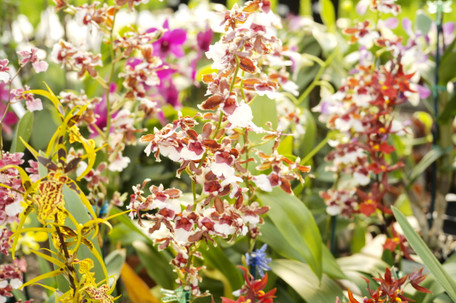The Orchid Collection at Tonkadale
Posted by Aaron Barton on Oct 20th 2022
October 21, 2022
The Orchid Collections at Tonkadale
The more we learn about orchids, the more we learn to love them. Often thought of as a difficult plant to care for, orchids offer tremendous beauty, flower power, and logenvity. Lately, we have been able to source new and different, even rare varieties, of orchids from our grower partners in Hawaii. Check out three of our favorite specimens as we showcase our current collection.
Oncidium (on-SID-ee-um) Ruth’s Rainbow ‘Over the Rainbow’ is a gorgeous Oncidium hybrid developed in 2009 by H&R and is a cross between Oncidium sphacetante (s-fah-seh-TAWN-t) and Oncidium sotoanum (soh-toh-A-num). A fragrant bloomer, ‘Over the Rainbow’ produces abundant showy panicles of delicate burgundy and pink blooms one to two times a year above deep green, strap-like leaves which emerge from storage organs called pseudobulbs at their base. Like other Oncidium of tropical origin, this orchid prefers intermediate to warm temperatures, generally between 60F and 85F, and bright light, even tolerating some direct sunlight, thriving in bright east, south, or west windows or placed 6-12” from a grow light. Water thoroughly with room temperature water when your orchid medium is at least halfway dry, generally every 5-10 days depending on the environment and time of year, and maintain conditions between 40 and 60 percent humidity, using a humidifier or pebble tray to supplement humidity as needed. Fertilize regularly when actively growing, one to two times per month, with an orchid-specific fertilizer at half the recommended rate.
Brascidostele (brah-sid-OH-steel) Gilded Tower ‘Mystic Maze’ is an incredible hybrid orchid developed by J.W. McCully in 2005 and is a cross between the hybrid parents Brassostele (brah-SO-steel) ‘Summit’ and Brassidium (brah-sid-EE-um) ‘Gilded Urchin’. ‘Mystic Maze,’ like other Oncidinae, generally bloom one to two times per year when new growth matures, usually occurring in spring and fall. Plants produce one to two tall, long-lasting inflorescences up to three feet tall with 10-15 blooms each. ‘Mystic Maze’ produces large, usually five- to six-inch-wide star-shaped blooms, bright yellow in color with deep red-brown markings on the petals and sepals and bright red markings along the lip of the bloom. These showy panicles shine above deep green, strap-like leaves that also emerge from a prominent pseudobulb that aids in water retention. Like Oncidium Ruth’s Rainbow ‘Over the Rainbow,’ this orchid also prefers intermediate to warm temperatures, generally between 60F and 85F, and bright light, even tolerating somedirect sunlight, thriving in bright east, south, or west windows or placed 6-12” from a grow light. Water thoroughly with room temperature water when your orchid medium is at least halfway dry, generally every 5-10 days depending on the environment and time of year, and maintain conditions between 40 and 60 percent humidity, using a humidifier or pebble tray to supplement humidity as needed. Fertilize regularly when actively growing, one to two times per month, with an orchid-specific fertilizer at half the recommended rate.
Psychopsis (sigh-COP-sis) Mendenhall ‘Hildos’ is an incredibly unique, long-blooming orchid hybrid, belonging to the Psychopsis genus of only four species and their related hybrids. Sold as mericlones, cloned from meristem tissue of the original parent orchid, not unique seedlings, ‘Hildos’ is a hybrid developed by Carter & Holmes in 1988 and is a cross between the species orchid Psychopsis papilio and hybrid parent Psychopsis ‘Butterfly’. Flowering at intervals throughout the year, Psychopsis possess tightly clustered, flattened, wrinkled pseudobulbs often with red mottling, which each produce a single bloom spike of moderate height, around 10 inches tall above solitary, erect, olive-green leaves with beautiful deep red, mottled coloration. Psychopsis inflorescences are jointed, sympodial (arched), wiry panicles whose buds bloom successively, with variation in size and color between blooming instances and even along the same spike, with each individual flower lasting an average of about ten days. Requiring no rest period between blooming instances, Psychopsis can bloom successively for years on end in optimal conditions, as long as ten years consecutively, and as such, spikes should not be removed until they are yellowed and obviously spent—even broken inflorescences will branch and continue to bloom. Living up to their common name of “Butterfly Orchid,” Psychopsisproduce intricate flowers resembling a butterfly, with a trio of delicate deep red-brown, narrow sepals and petals, sometimes with some yellow coloration throughout, at the top of the bloom, much like a butterfly’s antennae, above down swept bright yellow and red-orange mottled lateral sepals, often thought of as the “wings” of the bloom, framing the large, three-lobed lip with a bright yellow center edged in red-orange coloration to bring together the iconic, absolutely stunning blooms of this amazing orchid. As a more unique species, care of these orchids is a bit more involved and specific to ensure your success. Psychopsis prefer intermediate to warm temperatures of around 70F to 90F in very humid conditions of around 80% relative humidity along with great air circulation, intolerant of stale conditions. These orchids prefer lightly shaded conditions, generally preferring bright, indirect light, thriving in east or west windows or about 12” from a grow light, and like to dry out slightly between waterings, sensitive to overwatering and root disturbance. Psychopsis are also very sensitive to salt and mineral buildup in the soil, so while plants will benefit from a light fertilizing at a quarter to half strength one to two times a month or about every third or fourth watering when actively growing, soil should be flushed with fresh water regularly to avoid fertilizer deposit formation that will burn the sensitive roots. This is not the most beginner friendly orchid available but will be a deeply rewarding option for those up for a challenge.
To learn more about how to care for orchids, check out our Orchid Care blog.

